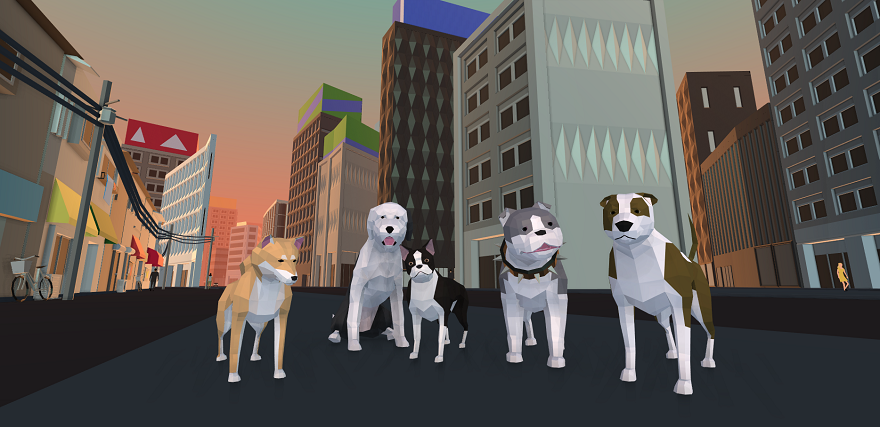You’ll sniff out fun in this urban dog simulator

Watch Disney’s middling 1988 animated film Oliver & Company and you’ll hear a Jack Russell Terrier voiced by Billy Joel sing about the rhythm of New York City. “Why should I worry,” he howls in one song early on, a long link of sausages dancing around his neck. He might be a homeless stray, but he’s got “New York heart.” Somewhere in-between Joel’s hammed-up Brooklyn accent and the film’s meandering adaptation of Oliver Twist lies the joyful squalor of a bunch of stiffly animated animals trolling the streets of a vast concrete jungle. In an upcoming expansion to his project Dog Park, designer Kevin Cancienne wants to capture the strange delight of being one of those dogs.
“I think one of the things that appeals to me about being a dog in that kind of space is how alienating it can all be,” Cancienne told me. “As a dog, the city wasn’t made for you.” Dense, crowded spaces like these are filled with as many possibilities for a dog as limitations. “You’re the wrong shape and the wrong size and there are tons of places you’re not welcome and you don’t quite understand how it’s all supposed to work,” he explained.
In Dog Park, a multiplayer game where users interact with one another as different canines, Cancienne wanted for people to try an experience play through the non-zero sum eyes of their pets. As Cancienne explained to Kill Screen last year, “When it comes to play, the dog’s only goal is to keep on having more fun.” In “City Dog,” a working title for the new project, he wants players to try encountering the rest of the world through this perspective and experience both the joys and fears that come with it. “I want to make an open world game where you start out as the least important character in that world, and more or less stay that way,” said Cancienne.
For the last several months, he’s been working on taking the interactive parts of Dog Park and expanding on them into a single-player adventure in a much larger, randomly generated city. Instead of using a place like Manhattan, however, Cancienne wanted something more conducive to the thrills of being a dog on the loose. “I started working on the procedural city stuff shortly after returning home from a trip to Tokyo,” he explained, “and Tokyo’s a great example of that kind of urban landscape.” Unlike the “predictable grids” of some of America’s larger cities, he felt the “organic, twisty, narrow shapes” of Asian and European cities offered more interesting spaces to “get pleasantly lost in.”
“I wonder whether the dog really saw it that way”
While the vine Cancienne posted of “City Dog” makes tearing down city streets look fun and lighthearted, I asked him if he’d ever lost one of his own dogs. “I have, very luckily, never lost my dog in the city, or anywhere,” he said. “She’s very attached to us, though, and isn’t prone to wandering.” Found alone in a Washington Heights basement by a rescue group, Cancienne adopted Princess after fostering her for a few weeks.
While working on the game he did mention thinking about a dog he used to have years ago. “[He] was found wandering the streets in Williamsburg, going door to door apparently looking for food and shelter, before someone let him in.” He also thought about the story of Hachik?, an Akita dog born on a farm near the city of ?date who returned to the same train station for nine years after his owner had died. “When humans tell the story, we say it’s about loyalty and bravery, but I guess I wonder whether the dog really saw it that way,” said Cancienne. Wondering about the dog’s daily existence, whether he kept returning to the same spot because he missed his owner or because he was simply scared and hungry, helped inform Cancienne’s approach to “City Dog.”
In his 1974 paper “What is it like to be a bat?” philosopher Thomas Nagel concluded that no matter how much information he had, there would always be limits to his ability to imagine the life of a bat, an intangible quality of its subjective experience that he would never have access to. Dog Park and “City Dog” might not be able to answer the question, “What’s it like to be a dog?” but together they offer an aesthetically playful and interactive way of exploring it. With the latter focusing on sniffing, collecting food, and negotiating a space filled with humans, and the former more narrowly tailored to the mechanics of dog-to-dog play, Cancienne is able to get at the question from more sides.
“I’m looking to release the two games as a package,” he told me. “I see them as two sides of the same coin.” In this way, the “fantasy” of being a dog that Cancienne is trying to create would be incomplete without both. He said he plans to launch a crowd funding campaign “soon-ish” in order to complete them.



